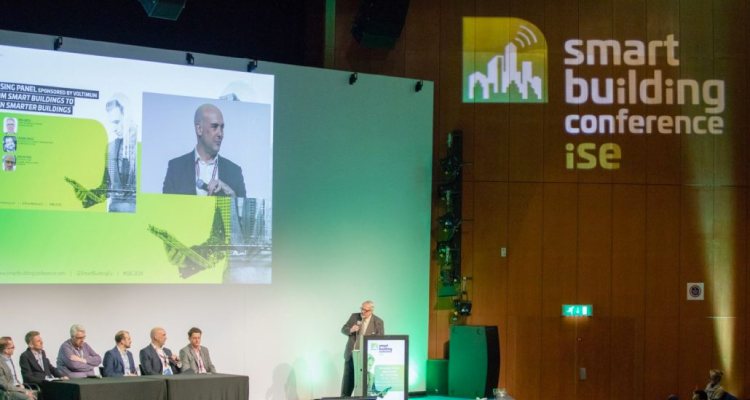Smart Buildings – Now or Never?
By Howard A. Nunes, CTS
President/CEO, PepperDash
 In the world of residential AV, we routinely integrate all sorts of building sub-systems. Often called smart homes, this new generation of residence involves a high level of coordination and automation among entertainment, climate, lighting, security and more exotic systems such as fountains and driveway heaters. But home automation is not being driven by HVAC or lighting installers. It is being driven by entertainment system installers. Yes, custom AV people.
In the world of residential AV, we routinely integrate all sorts of building sub-systems. Often called smart homes, this new generation of residence involves a high level of coordination and automation among entertainment, climate, lighting, security and more exotic systems such as fountains and driveway heaters. But home automation is not being driven by HVAC or lighting installers. It is being driven by entertainment system installers. Yes, custom AV people.
In the world of commercial AV, however, we touch only a handful of non-AV sub-systems, and then rarely and peripherally. There is virtually no movement towards a similar scale of building system automation from the commercial AV community. Why?
There are a few key differences between the residential and commercial markets that influence this. Sure, the equipment is different, and home AV systems are driven by entertainment rather than information management. But I don’t think those factors dominate the issue. Rather, there is a dramatic difference in the perception of opportunity. In the home, there is usually a direct relationship between the dealer/integrator and the principal decision maker, the homeowner. The dealer/integrator is free to discuss and explore the homeowner’s needs and desires as a trusted advisor, then suggest options that cover as broad a spectrum as their imaginations allows. Early on, AV dealers saw the potential opportunity and went after it. Residential AV dealers/integrators have since become the leaders in home-automation services.
On the other hand, commercial AV dealers/integrators typically see only the projects in front of them. Those projects are usually capital investments being implemented as part of an overall strategy, a strategy that rarely is shared with “the AV people.” In commercial AV, we also have a robust design consulting community, which is absent in residential situations. Moreover, the design community works within a construction culture that demands a bidding process in which the integration work is often commoditized, leaving little room for the dealer/integrator to explore solutions with the end customer. This leaves the task of “automation imagineering” to the design consultants, who are often more focused – and budgeted – to address technical audio and video challenges, generate bid documentation, and keep the project under control.
The issue is complicated by corporate/institutional cultural silos, which historically have kept AV relegated to the level of room furnishings, owned and operated by facilities managers. As a result, AV used to be separated from CXO-level strategic thinking. In the last decade, however, fueled by rising travel costs, declining technology prices, and the ubiquity of TV, high-level management has embraced the critical role of “communication technology” for presentation and conferencing. Communication technology is now a standard IT budget item, which is a defining element of AV/IT convergence. (A topic for another article!)
What to do about it? At the InfoComm100 meeting in early April, former InfoComm International President and LEED AP Scott Walker publicly suggested that the AV industry should step up and take ownership of the inevitable Smart Building revolution. Unlike in Home Automation though, we already have some commercial competition. Building Management System (BMS) companies have assumed the task of automating lighting and HVAC to optimize energy consumption. Access control companies have joined forces with network security and asset management players. And internal IT department resources are very interested in the topic. Yet there is still a gap, particularly in smaller and mid-sized facilities. Fully unified solutions don’t yet exist.
Who is better positioned to take on that role than those who manufacture, specify, install and program what we now refer to as “AV control systems”? Today we see only room management solutions. But tomorrow, with a little imagination and the ability to perceive a good opportunity, we could see a distributed building management architecture: the backbone of Smart Building solutions. But the AV community has to take the initiative. We have to open the dialog with high-level corporate and institutional leaders, with building management companies, and with architects. It’s up to us to take on the role of Trusted Advisor in the Smart Building opportunity. Carpe diem!
Copyright 2009, PepperDash Technology Corp. All rights reserved.
 Howard A Nunes, CTS, is the President/CEO of PepperDash Technology Corp. (http://www.pepperdash.com,)a control programming firm headquartered in Boston, MA. He is a former member of the InfoComm Board of Governors, and has served as a member of the Green AV Task Force Steering Committee and Governance Committee, as Chair of the Independent Programmers Council, Chair of the Intellectual Property Rights Committee, and Liaison to the Independent Consultants in Audiovisual Technology (ICAT) Council. He is an InfoComm Adjunct Faculty member and has co-authored the Independent Programmers Council Charter, Dashboard for Controls Design Reference, Dashboard for Controls Integrator’s Guide, Roadmap to Control, and Roadmap to Control Quick Reference Guide.
Howard A Nunes, CTS, is the President/CEO of PepperDash Technology Corp. (http://www.pepperdash.com,)a control programming firm headquartered in Boston, MA. He is a former member of the InfoComm Board of Governors, and has served as a member of the Green AV Task Force Steering Committee and Governance Committee, as Chair of the Independent Programmers Council, Chair of the Intellectual Property Rights Committee, and Liaison to the Independent Consultants in Audiovisual Technology (ICAT) Council. He is an InfoComm Adjunct Faculty member and has co-authored the Independent Programmers Council Charter, Dashboard for Controls Design Reference, Dashboard for Controls Integrator’s Guide, Roadmap to Control, and Roadmap to Control Quick Reference Guide.
Author’s Contact Info
hnunes@pepperdash.com
800.377.9112 x402
AIM: PepperDashInfo





